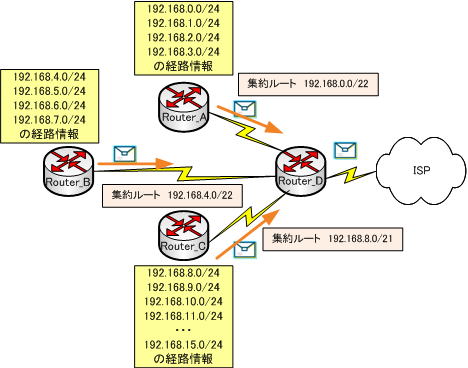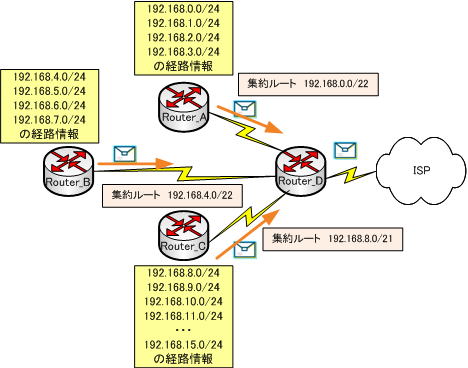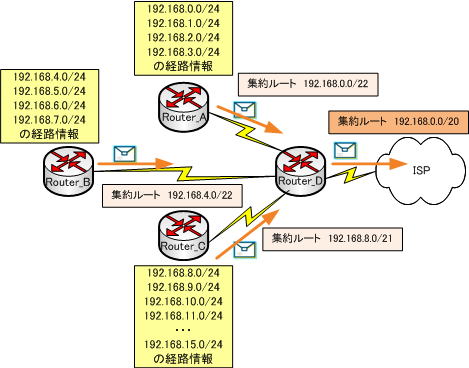VLSM and Route Aggregation
VLSM and Route Aggregation
VLSM and route summarization
With the spread of the Internet, the number of network routes around the world has increased dramatically. Therefore, routers have to learn a huge amount of route information, and the number of entries in the routing table is huge.
As the size of the routing table increases, the CPU and memory of the router will be burdened and the overhead will increase. Searching through this huge number of entries for each received packet is a very heavy task.
Therefore, by consolidating multiple networks (subnets) into one, a mechanism is being considered to reduce the size of the routing table and reduce the burden on the CPU and memory. This mechanism is called route aggregation, and is realized by hierarchical addressing using VLSM.
Route summarization results in less route information in routing updates, reducing bandwidth utilization. Also, since the number of entries in the routing table is reduced, the table search speed is increased.
Next, we will explain how route aggregation is performed using the diagram below.

On Router_A
192.168.0.0/24
192.168.1.0/24
192.168.2.0/24
192.168.3.0/24
has route information for Since the upper 2 octets are common, focus on the 3rd octet.
| 0 (decimal) = 000000 | 00 (binary) 1 (decimal) = 000000 | 01 (binary) 2 (decimal) = 000000 | 10 (binary) 3 (decimal) = 000000 | 11 (2 hexadecimal) |
The upper 6 bits are common.
That is, the 16 bits of the upper 2 octets and the upper 6 bits of the 3rd octet
16+6=22
22 bits are common.
Aggregate roots are those in which the bits in the common part and the rest of the bits are all 0.
192.168.0.0/24
192.168.1.0/24
192.168.2.0/24
192.168.3.0/24
The aggregate route for is “192.168.0.0/22”.
On Router_B
Consider the same for Router_B.
192.168.4.0/24
192.168.5.0/24
192.168.6.0/24
192.168.7.0/24
has route information for Since the upper 2 octets are common, focus on the 3rd octet.
4 (decimal) = 000001 | 00 (binary)
5 (decimal) = 000001 | 01 (binary)
6 (decimal) = 000001 | 10 (binary)
7 (decimal) = 000001 | 11 (2 hexadecimal)
The upper 6 bits are common.
That is, the 16 bits of the upper 2 octets and the upper 6 bits of the 3rd octet
16+6=22
22 bits are common.
Aggregate roots are those in which the bits in the common part and the rest of the bits are all 0.
192.168.4.0/24
192.168.5.0/24
192.168.6.0/24
192.168.7.0/24
aggregate route will be “192.168.4.0/22”.
On Router_C
Think the same for Router_C.
192.168. 8.0/24
192.168. 9.0/24
192.168.10.0/24
192.168.11.0/24
192.168.15.0/24
has route information for Since the upper 2 octets are common, focus on the 3rd octet.
8 (decimal) = 00001 | 000 (binary)
9 (decimal) = 00001 | 001 (binary)
10 (decimal) = 00001 | 010 (binary)
11 (decimal) = 00001 | 011 (binary)
15 (decimal) = 00001 | 111 (binary)
The upper 6 bits are common.
That is, the 16 bits of the upper 2 octets and the 5 upper bits of the 3rd octet
16+5=21
21 bits are common.
Aggregate roots are those in which the bits in the common part and the rest of the bits are all 0.
192.168. 8.0/24
192.168. 9.0/24
192.168.10.0/24
192.168.11.0/24
192.168.15.0/24
The aggregate route for is “192.168.8.0/21”.
Router_A, Router_B, and Router_C, for Router_D,
Router_A has route information for “192.168.0.0/22”
Router_B has route information for “192.168.4.0/22”
Router_C has route information for “192.168.8.0/21”
I’m sending you a routing update.
Router_D will explain what route to send to the ISP.

On Router_D
192.168.0.0/22
192.168.4.0/22
192.168.8.0/21
has route information for Since the upper 2 octets are common, focus on the 3rd octet.
0 (decimal) = 0000| 0000 (binary)
4 (decimal) = 0000| 0101 (binary)
8 (decimal) = 0000| 1000 (binary)
The upper 4 bits are common.
That is, the 16 bits for the upper 2 octets and the upper 4 bits for the 3rd octet
16+4=20
20 bits are common.
Aggregate roots are those in which the bits in the common part and the rest of the bits are all 0.
The route information of each subnet, which was 16 from “192.168.0.0/24” to “192.168.15.0/24”,
It will be aggregated to “192.168.0.0/20” and updated to the ISP.

By aggregating routing information in this way, the routing information handled by each router can be reduced.
However, it is necessary to assign IP addresses hierarchically so as not to create discontinuous subnets. If IP addresses are not assigned in a hierarchical fashion, discontinuous subnets may occur, resulting in inconsistencies due to aggregation.


